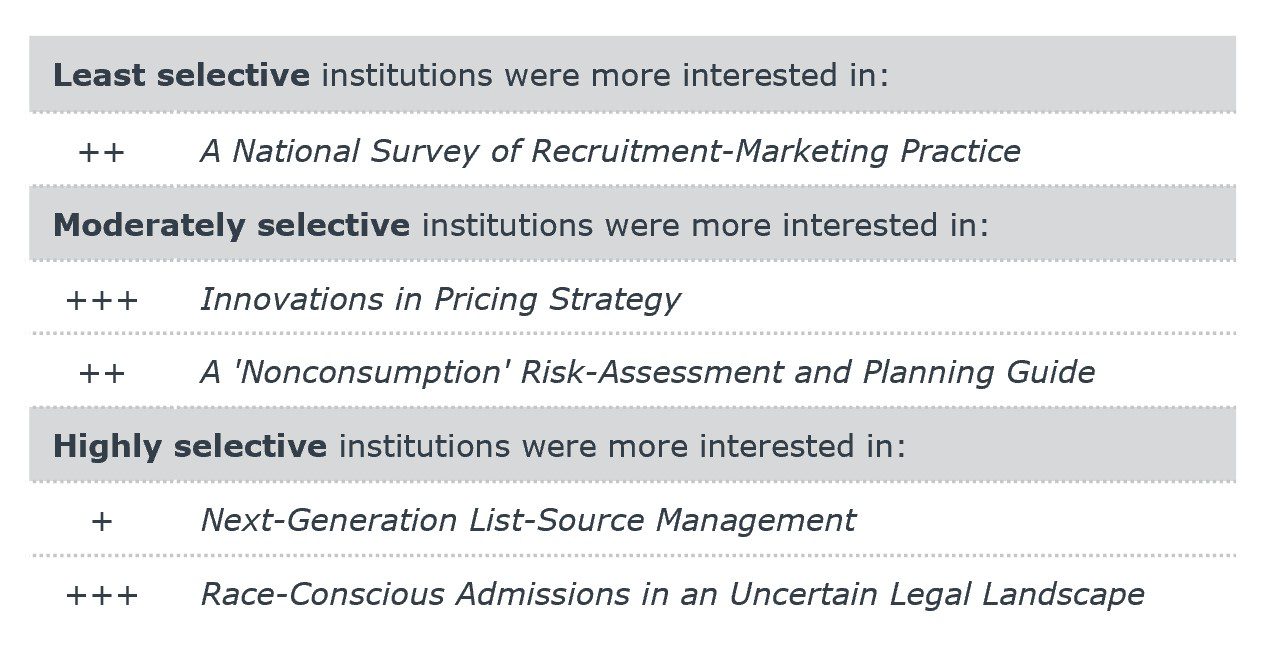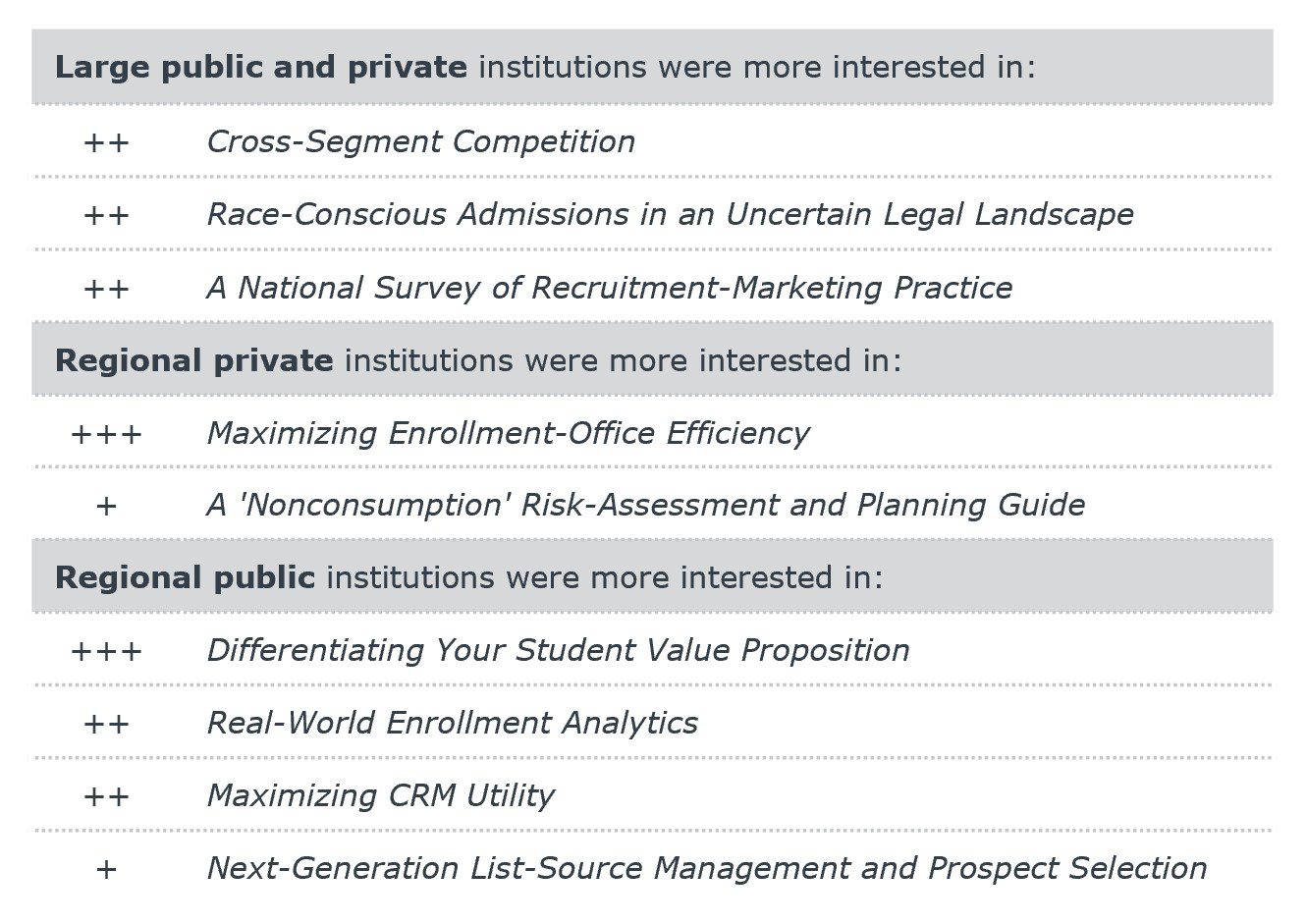What do enrollment leaders care most about in 2023? Review our poll results to find out.
January 30, 2023, By Madeleine Rhyneer, Vice President of Consulting Services and Dean of Enrollment Management
Each year, EAB surveys enrollment leaders at our partner institutions to learn what issues are top of mind for them. In addition to helping set an editorial agenda for our research publications (see here, and here, and here for past examples), this work gives us a unique read on what’s happening in higher education markets around the country. In this post, I’m going to share highlights from our most recent survey with you, using the results as a framework for broader observations and speculation about the forces defining today’s enrollment challenge.
Top Topics and Trends
Let’s start with a high-level snapshot of the survey results.
Our poll presented participants with fifteen proposed research initiatives, instructing them to pick their top five. Below are the topics that scored the highest, in descending order of popularity. (The numbers show the percentage of respondents who picked each topic).
Top five concerns
- Mapping the Enrollment Landscape of the Near Future
Five Coming Changes that Admissions Leaders Should Start Planning for Today – 56% - Innovations in Pricing Strategy
How To Frame Your Cost of Attendance for an Increasingly Value-Focused Prospect Pool – 52% - Differentiating Your Student Value Proposition
A Comprehensive Framework for Assessing Your Institution’s Brand in Market Context – 44% - Recruiting “Gen P”
How the Pandemic Has Permanently Altered Students’ College Search Behaviors and Academic Preparedness – 41% - A National Survey of Recruitment-Marketing Practice
Where Are High-Performing Enrollment Teams Focusing Their Most Intensive Efforts, and Why? – 33%
Click here to see all fifteen topics tested and their scores
- Mapping the Enrollment Landscape of the Near Future
Five Coming Changes that Admissions Leaders Should Start Planning for Today – 56% - Innovations in Pricing Strategy
How To Frame Your Cost of Attendance for an Increasingly Value-Focused Prospect Pool – 52% - Differentiating Your Student Value Proposition
A Comprehensive Framework for Assessing Your Institution’s Brand in Market Context – 44% - Recruiting “Gen P”
How the Pandemic Has Permanently Altered Students’ College Search Behaviors and Academic Preparedness – 41% - A National Survey of Recruitment-Marketing Practice
Where Are High-Performing Enrollment Teams Focusing Their Most Intensive Efforts, and Why? – 33% - Real-World Enrollment Analytics
How to Equip Your Team with Essential Report Libraries and Critical Ad Hoc Reporting Capabilities – 32% - Maximizing Enrollment-Office Efficiency
How to Maintain High Service Standards in the Face of Historic Staffing Shortages – 32% - Next-Generation List-Source Management
How Are Changes in Test-Taking and Name-Source Pricing Models Impacting Recruitment Strategy? – 31% - A “Nonconsumption” Risk-Assessment and Planning Guide
Why More Students Are Opting Out of College and What You Can Do About It – 29% - Cross-Segment Competition
How Market Share Is Shifting Between College Types and What This Means for Your Recruitment Strategy – 25% - Maximizing CRM Utility
How to Realize the Latent Potential of Your Data Capture and Communications Systems – 22% - The State of the FAFSA
How High-Performing Teams Are Navigating an Uncertain and Rapidly Changing Financial Aid Landscape – 22% - A Guide to the Emerging Reverse-Admissions Landscape
How the Ability to Offer Proactive Admission and Aid Offers at Scale Is Transforming College Search – 19% - Race-Conscious Admissions in an Uncertain Legal Landscape
How Should Enrollment Leaders Be Preparing for Potential Fallout from Recent and Future Supreme Court Rulings? – 19% - International Advantage
How to Keep Your Overseas Recruitment Efforts Aligned with Rapidly Evolving Patterns of Demand – 16%
Three broader trends
The poll results underscored three broader trends that defined the enrollment challenge in the past year.
Enrollment teams are sharpening their competitive tools
The pandemic era has seen the convergence of several factors boosting competition between colleges, including a shrinking pool of college goers, growing consumer price sensitivity, widespread adoption of test-optional admissions, and a more general reduction in barriers to applying. Our poll showed that enrollment leaders are, accordingly, focusing intently on the fundamentals of their value proposition for students-their price and the substance of their colleges’ offerings, which correspond to the second and third-highest-scoring poll topics respectively. Also among the top five areas of interest for respondents was recruitment marketing-colleges’ primary toolkit for influencing students’ perception of their value proposition.
Infrastructure improvements remain on the back burner
While enrollment leaders are clearly interested in strategies for generating demand and converting prospects, they are less intently focused on the infrastructure required to execute effectively on those aims. Related topics, such as data/analytics, process efficiency, and CRM best practices were chosen by considerably fewer respondents, with none of these topics breaking the top five. This is understandable-you’re unlikely to make your class if you don’t have enough applicants, no matter how great your processes are. Even so, this result is a little surprising given the very serious problems that staffing shortfalls have created for admission teams. It seems likely that process-related topics will climb the priority list soon, as enrollment leaders come under increasing pressure to wring every bit of potential enrollment out of their applicant pools-a goal that demands top-notch execution on core admission processes.
Admission teams are scrambling to adapt to “Gen P”
The ways in which new generations of high school graduates differ from their predecessors is a perennially popular topic with enrollment leaders, these differences having profound implications for how to engage students. Lately, the pandemic has prompted remarkably large and sudden changes in college-goers’ mindsets, giving this topic more urgency than ever.
Particular concerns include students’ psychological health, academic preparedness, and confidence levels. Even prestigious colleges are seeing greatly increased failure rates for core introductory courses, and more than 60% of students polled by EAB cite being mentally unprepared or needing time off as reasons for opting out of college. Predictably, the related topic on our poll of enrollment leaders ranked high, taking the number four slot.
How do school segments compare?
In addition to underscoring the general trends shared above, the survey, which engaged a broad spectrum of institution types, from small regional privates to flagship publics, also provided valuable insight into how enrollment challenges and opportunities differ across school segments. A more granular understanding of those differences reveals much not only about concerns particular to those segments but also about the challenges facing the enrollment community more generally. The remainder of this post focuses on an analysis of these differences.
Privates versus publics
The table below shows where poll results for private and public institutions diverged most significantly from the average. (More “+” signs mean greater divergence).

A closer look at private colleges and universities
- Privates were a lot more interested than their public counterparts in pricing strategy—not a big surprise given privates’ greater dependence on tuition discounting as a yield lever.
- Private colleges and universities were also much more interested than publics in strategies for maximizing enrollment-office efficiency. One likely reason is the higher prevalence among privates of detailed—i.e., labor-intensive—applicant review. (By way of corroboration, selective institutions were also more likely than their less selective counterparts to be interested in efficiency).
A closer look at public colleges and universities
- While public colleges did not show the same outsized interest in pricing strategy as did privates, this topic was still popular with them—more than a third of respondents at publics included it among their top picks.
- Public colleges (regional publics especially) were more interested than their private counterparts in enrollment data and analytics. One possible explanation for this is the more onerous reporting requirements these institutions face due to their state affiliation. Another may be lean staffing—a circumstance that makes data/analytics especially appealing, for role it can play in automating labor-intensive processes such as applicant assessment (a particular concern for regional publics given their historically heavy reliance on test scores and the sudden reduction in score availability during the pandemic). It also seems likely that some public institutions’ interest in data/analytics is a reflection of their need to play catch-up in this area.
- Public institutions were also more interested in improved list-source management. Like their interest in data/analytics, this may be related to their historically heavier reliance on test scores and high school GPA, list sources being a key conduit for this information.
Cuts by selectivity
The table below shows where results for surveyed colleges diverged most significantly from the average, by selectivity.

A closer look at least-selective institutions
- Least-selective institutions showed greater interest in recruitment-marketing practice. This likely reflects the greater need on their part to generate demand—a result, in turn, of their less robust brands and the fact that college-going is not a given for the core demographics they serve.
A closer look at moderately selective institutions
- Moderately selective institutions showed outsized interest in pricing strategy—likely a reflection of intensifying competition between them and more selective institutions, which, thanks to test optionality, are now able to recruit students who previously would have fallen below their test-score cutoffs (i.e., students who formerly would have ended up at moderately selective schools). In this context, price becomes a more important recruitment lever than ever.
- Moderately selective institutions were also significantly more interested than other types of schools in “nonconsumption”—the phenomenon of high school graduates choosing not to pursue college. This result is surprising. While nonconsumption is commonly believed to be a problem primarily of community colleges and least-selective four-year institutions, respondents from moderately selective schools in our survey chose this topic twice as often as their peers at least-selective schools. This may be a reflection of particularly intense competitive pressures facing moderately selective colleges and a correspondingly elevated sensitivity to any factors that might decrease demand for their services.
A closer look at highly selective institutions
- Highly selective schools were far more interested in race-conscious admissions, with 38% of respondents including it in their top five (versus 3% of moderately selective schools and 17% of least selective schools). This makes sense. While the least selective schools are often already enrolling disproportionately high numbers of underrepresented students, and moderately selective schools often feel they can’t enroll more individuals from these populations for financial reasons, highly selective schools, many of which are intent on enrolling more underrepresented students—and have the means to do so—often struggle to find, effectively recruit, and enroll enough students with the right level of academic preparation. Interest in this topic was also likely boosted by the expectation that the Supreme Court will rule against affirmative action this summer.
- Highly selective schools were more interested in list-source management, with 38% of respondents including it in their top five (versus 31% overall)—a fact that may be related to their interest in enrolling underrepresented students. In their national search for candidates who meet their rigorous admit criteria, highly selective institutions must bring to bear all possible resources, key among them lists of college-bound students. Also significant in this context is the fact that list sources are likely to play an important role in workarounds to coming legal constraints on race-based admissions.
Large institutions, regional privates, and regional publics
This section examines key segments within segments, including large public and private institutions, regional private institutions, and regional public institutions, beginning with the table below, which summarize where results for schools in these segments diverged from the average.

A closer look at large public and private institutions
- Large public and private institutions’ greater interest in cross-segment competition may be a result of the new opportunity that test optionality has created for them to draw students from smaller, less selective institutions. It may also signal the continuation of an established trend of flagship publics pulling value-seeking students away from higher-priced but academically comparable private institutions.
- Large institutions’ greater interest in recruitment marketing was paired with moderately lower levels of interest in list sourcing (24% versus 31% overall). This may reflect a belief on their part that their challenge lies less with demand generation and more with conversion of interested candidates. This conclusion, while understandable (given their greater brand recognition), suggests that they may be underestimating the positive impact on enrollment outcomes that advanced demand-generation techniques can have even for institutions with strong brands.
- Large institutions’ greater interest in race-conscious admission is likely a reflection of the overrepresentation within this group of selective institutions, which more commonly make the recruitment of underrepresented students an explicit priority. This interest would appear to be at odds with their relatively low interest in list sourcing, which is an essential element of enrollment leaders’ diversity-recruitment toolkit and one that will become even more important if, as expected, the Supreme Court ends up ruling against affirmative action in the summer of 2023.
A closer look at regional private institutions
- Regional privates showed higher than average interest in efficiency. This is likely a combination of them facing greater resource constraints than their more prestigious private counterparts and also being more inclined than regional publics to undertake close, detailed review of applicants. They were, however, also considerably less interested in analytics. This may reflect an underappreciation of the degree to which data and analytics can improve the efficiency of enrollment-office workflows (e.g., by helping triage staff time).
- Regional privates were a lot less interested in international student recruitment than were regional publics (8% versus 20%).
A closer look at regional public institutions
- Regional publics were much more interested than other schools in differentiating their student value proposition. Like all regional institutions, public and private, regional publics struggle with more limited brand recognition relative to larger super-regional schools. They are also more constrained than their private counterparts in terms of the academic programs and nonacademic amenities they can offer, leaving them to compete primarily on the basis of price—which, while a key factor in college choice, has limited potential as a positive differentiator.
- Regional publics were also a lot more interested than other school segments in CRM utility and enrollment analytics. Perhaps counterintuitively, this seems unconnected to an interest in improved efficiency, a topic in which regional publics’ interest was well below average (20% versus 32%). It may, instead, be a reflection of the fact that they have, historically, not had to recruit students as actively as their private counterparts. Now, as competition is intensifying, publics are having to more actively woo prospects, and, accordingly, find themselves under new pressure to develop more robust recruitment-marketing infrastructure. This would also explain their outsized interest in list source management.
Cuts by enrollment-leader seniority
This section examines how survey responses varied between enrollment VPs and non-VPs (i.e., less-senior leaders). As above, we begin with a table summarizing topics on which respondents from each group diverged from average.

A closer look at enrollment VPs
- Predictably, more-senior leaders showed greater interest in topics related to higher-level enrollment strategy—the enrollment landscape of the near future and cross-segment competition.
- Their interest in pricing strategy, while below average, was still considerable, with almost half of senior leaders including this topic in their top five.
- One topic on which more-senior and less-senior titles differed very considerably was that of nonconsumption, which was chosen by 41% of non-VPs but just 21% of VPs. This result appears counterintuitive insofar as nonconsumption constitutes a major strategic challenge for enrollment and would therefore presumably be of great interest to enrollment VPs. One possible explanation is that nonconsumption is simply more evident to non-VP enrollment leaders due to their closer proximity to the front lines.
A closer look at non-VP enrollment leaders
- Non-VP enrollment leaders were more interested than VPs in nonconsumption and in pricing. This is counterintuitive in that both topics are ones with significant strategic implications—i.e., ones that fall more directly within the purview of senior-most leadership—and represent areas for which junior leaders are, relatively speaking, poorly positioned to effect change. One possible explanation is non-VP staffers’ closer proximity to the enrollment front lines; being more directly on the hook for converting students, they may also have a more complete view of barriers that stand in the way of doing so (including price).
Hopefully, the thoughts I’ve shared above will be of some help as you chart your own course through an increasingly uncertain enrollment landscape. We’ll provide you with more definite and specific guidance in the coming months in the form of white papers addressing some of the most pressing priorities identified through the survey.

More Blogs

How one university supports online students’ engagement and belonging

4 strategies to engage graduate and adult leads with social proof marketing
